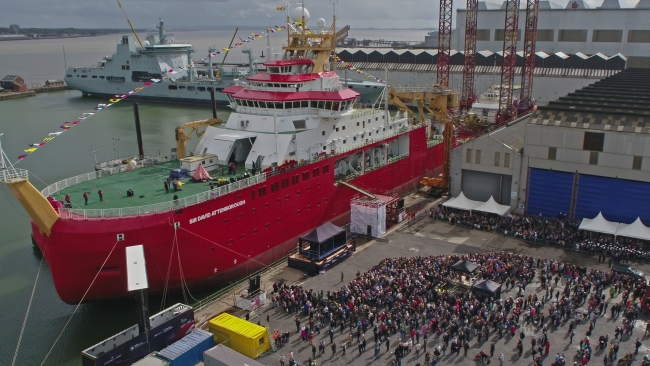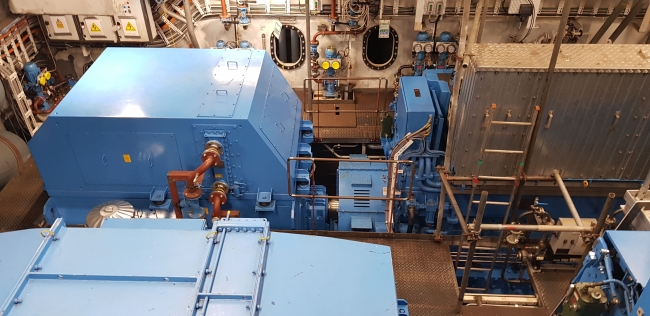5 minute read • published in partnership with Atlas Copco
Atlas Copco marine compressors provide air power for RRS Sir David Attenborough research vessel
Shipbuilders Cammell Laird Construction has installed Atlas Copco marine-duty compressors aboard one of the most advanced polar research vessels in the world, RRS Sir David Attenborough.
The new polar ship, commissioned by Natural Environment Research Council (NERC), built by Cammell Laird and operated by British Antarctic Survey is a research platform that will transform how shipborne science is conducted in the Polar Regions. Its commissioning is part of a significant government polar infrastructure investment programme designed to keep Britain at the forefront of world-leading research in Antarctica and the Arctic. This £200m commitment represents the UK Government’s most substantial investment in polar science since the 1980s.
As an integral part of shipboard operations in the engine room or deck site environments, the marine compressors needed to be specifically designed for the harsh conditions such as the RRS Sir David Attenborough will experience while operating in mid-ocean or sea ice, days or weeks away from temperate landfall and servicing facilities.

Cammell Laird Construction has installed Atlas Copco marine-duty compressors aboard the RRS Sir David Attenborough polar research vessel / Picture courtesy of BAS
Within the practical constraints of minimum power consumption and restricted installation space, Cammell Laird had to ensure that the performance and build quality of the compressed air system could meet its criteria for reliability, energy efficiency, stability, safety, and regulatory compliance.
In addition to the overall requirement for a reliable and robust supply of compressed air for the many routine general air applications on the vessel, it was equally essential that high quality, clean dry air was available as instrument air for the vital bridge instruments. This was to ensure their accurate performance in monitoring and in driving engine control systems. Equally vital, there was a further demand for precision in the supply of high-quality air for the onboard scientific experiments and measurement operations that would be carried out.
This full spectrum of compressed air duties was met from Atlas Copco’s MAS range of marine compressors, technically advanced solutions that are fully optimised for shipborne use. The MAS family of 5-90 kW oil-injected screw marine compressors, derived from its premium GA range of stationary industrial units, sets the standard in marine compressed air production, combining low cost of ownership with reliable, energy-efficient performance.
Two central compressor systems
Atlas Copco’s successful response to Cammell Laird’s compressed air equipment tender saw the installation of two central compressor systems. For general service and scientific air applications, two MAS+ 55VSD water-cooled rotary screw compressors and accompanying FD 285 refrigerant dryers, together with filtration, air receivers and electronic drains, were installed. At the same time, the requirement for high quality, clean, dry, 7-8 bar instrument air and a supply of scientific air was met by a MAS15VSD air-cooled unit with ancillaries comprising an FD60 refrigerant dryer, 250-litre receiver, filtration and drain units.
Energy-efficient, low-noise operation
The energy cost-saving benefits of VSD technology in compressor design are already well known. However, the MAS+ 55 VSD compressors, as selected for the RSS Sir David Attenborough, go even further, offering on average 20% lower Specific Energy Requirement (SER) and average 50% less energy consumption compared to a regular MAS VSD model. On top of energy savings, there is a Free Air Delivery (FAD) increase of up to 12%.
A further contribution to energy-efficiency is derived from the MAS compressors’ controller. The Elektronikon® unit controls the compressor with feedback from the integrated converter to ensure maximum efficiency and complete protection of the compressor system. The controller features voltage-free contacts for alarms and read-out, and remote control is a standard feature. Furthermore, all pressure and temperature measurements can be monitored via the MAS units’ Elektronikon®, controller graphic display.
Low-noise operation too was an important factor for Cammell Laird. The MAS compressors onboard the RRS Sir David Attenborough are enclosed in a canopy, bringing their noise levels down by 14dB(A) to 69dB(A) − an additional boon for the research vessel, which was designed and built as a low-noise vessel in accordance with DNV codes ‘R’ and ‘S’.

Inside the Engine room of the RRS Sir David Attenborough / Picture courtesy of BAS
Compact dimensions and accessibility
The dimensions of the compressor units were also a critical feature in favour of installing Atlas Copco marine compressors. With engine room space always at a premium, marine users’ best option is to match the required performance to equipment offering the smallest footprint. The MAS compressors’ compact dimensions and unique vertical configuration offered the smallest footprint on the market not only for economical space usage but, during initial installation, allowed easy access through standard ship-sized doors.
For the same reason, air connections and ancillaries such as condensate drains are located at one side of each unit to allow maximum proximity to bulkheads and to provide ready access for routine maintenance procedures.
With stability at sea an equally important consideration, the MAS compressors’ component configuration has been designed to provide a low centre of gravity that minimises equipment stress even in severe running conditions.
Safety and regulatory compliance
The onboard compressors and air receivers are subject to inspection and certification by Lloyd’s Register of Shipping. The Atlas Copco compressor concept complies fully with the Lloyd’s Register Rules and Regulations of operating conditions for main and auxiliary machinery − essential to the propulsion and safety of the ship.
The compressor equipment’s construction also complies with the Green Passport regulations and guidelines which identify the hazardous materials onboard a ship, including quantities and locations. It is an essential part of the IMO’s task of promoting the safety of workers on ships and while reducing the environmental pollution generated by seagoing vessels.
Worldwide marine service support
Service support for the installation is provided in a seamless transition from inception and commissioning to full-time operational duties across the world. Atlas Copco’s global presence means that consultation, engineering and design can be carried out in the UK while servicing, spare parts supply, training and technical support can be supplied locally wherever it is required.
Raymond Smith, Business Development Manager at Atlas Copco, said: “Although our compressors are designed for the longest possible service intervals, we have to ensure service coverage is available where and when ship owners and operators need it. That’s why we operate an extensive service offering in most harbours in more than 100 countries around the world.”
